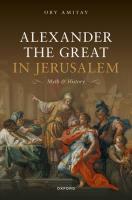
OUP (2025) h/b 209pp £84 (ISBN 9780198929529)
Few facts are certain beyond a reasonable doubt, but one that has a claim to be such is that cousins Elizabeth I Queen of England and Mary Queen of Scots never met. That fact was no deterrent to the fiction of Friedrich Schiller, whose verse-play Maria Stuart had its premiere in 1800 and served as the basis for the libretto of Donizetti’s 1835 opera Maria Stuarda. That pseudo-tradition was invented two to two and a half centuries after the Scots Queen was executed without ever having actually met her proxy executioner. A longer gap—some four and a third centuries—separates Jewish-Roman historian Josephus’s well-known account of Alexander of Macedon’s visit to Jerusalem from his passages through the Levant in 333-2 BC. But there is every reason for supposing that the latter alleged encounter is every bit as fictional, or more precisely mythical, as the former.
What Dr Amitay (University of Haifa, a former doctoral pupil of Erich Gruen to whom he dedicates this monograph) sets out to suggest (proof is not on offer), following in the wake of A.D. Momigliano (1979) and Daniel R. Schwartz (1990), is that the tradition to which Josephus was heir has its origins well back in the Hellenistic period, before the launching in Alexandria of the single most fertile source of Alexander-myth, the Alexander Romance (originally in Greek, hence a.k.a. the Pseudo-Callisthenes).
Specifically, he identifies in the epsilon recension of the AR the earliest surviving version of the—in his view probably, not absolutely certainly—fictional Jerusalem visit of Alexander. That recension was composed in the ninth century of the Common Era but, it is argued, is based ultimately on a work—named here the ‘Seleucid Romance’—hailing most likely from Seleucid Judaea in around 200 BC (ch. 1). Nor was the Josephus version of c. AD 100 the next earliest: between AR epsilon and his Antiquitates Judaicae (11.302-347, at 325-39, including its extraordinary and unbelievable scenario of Alexander prostrating himself before the High Priest) come—or are placed—two other accounts belonging to rabbinic Hebrew, not Greek, literature of the mid-1st BC to early 1st C AD.
The first is the story of Alexander’s meeting with Gviva Ben-Psisa, the hunchback warden of the Temple (Amitay translates its fullest version, pp. 68-9). This presents a ‘more passive and less benevolent’ Alexander than does the ‘Seleucid Romance’ (ch. 2). Next, from the same rabbinic milieu (sources: Babylonian Talmud and Megillat Ta’Anit; cf. synopses of MSS, 131-4), is the more positive tale of Alexander and High Priest Sim(e)on the Just (ch. 3). Amitay concludes plausibly that in both cases Alexander is being used in the Jewish tradition as a cipher or symbolic representative of actual Roman power-figures, as a way of accommodating Judaea by proxy to the new, often unwelcome, era of foreign rule.
Chapter 4, the shortest, is devoted to Josephus’s polished, synthesizing account. Amitay seems as interested in showing that it is not the earliest extant version of Alexander’s Jerusalem visit as he is in exploring the version on its own terms, probably because his interpretation of its underlying intent as ultimately self-serving is less controversial than his claims for its chronological posteriority.
Quite clearly, Dr Amitay is formidably learned, and (many) others will be more competent than I to judge the overall plausibility of his fundamental revision/reconstruction of the tradition or traditions of Alexander’s alleged visit to Jerusalem and what may have happened (or not) then and there. But as an outsider I was a little surprised that in a work in OUP’s excellent ‘Classical Presences’ reception series the following works were not included in the References (pp.185-97): Momigliano’s Alien Wisdom (CUP, 1975, repr. 1990); J. Peltonen Alexander the Great in the Roman Empire, 150 BC to AD 600 (Routledge, 2019); and, for comparison, C.T. Djurslev Alexander the Great in the Early Christian Tradition: classical reception and patristic literature (Bloomsbury, 2020). I would also have welcomed some discussion of the later, parallel Alexander-tradition that has him utterly impossibly visiting the successor capital of would-be global monotheism, Mecca.
That Arabian ‘visit’ was admirably covered in a recent British Library exhibition, of which the superbly illustrated catalogue was expertly edited by Richard Stoneman: Alexander the Great: The Making of a Myth (2022). No bones are made there of any possible historicity. Dr Amitay, on the other hand, ends his extraordinary study with a chapter entitled ‘From Myth to History’, in which he writes (p. 167): ‘As unexciting as the dealings of Alexander and the Judeans may have been, they surely took place’. ‘Surely’ I interpret as meaning ‘for sure’, whereas its other meaning ‘must have happened, but there’s no actual evidence’ is rather the nuance I prefer. For Alexander’s supposed visit to Jerusalem matters, that is, makes a difference to our understanding of the man and his achievements, solely in terms of myth understood as invented tradition—invented in this instance, as the Americans say, from whole cloth. Which is the case of so much of the entirety of the ‘Alexander story’ in all its innumerable multinational, multivariate recensions and receptions. One day, let’s hope, Dr Amitay will carry out the project he delineates in his Foreword, of exploring the Alexander-in-Jerusalem tradition from Josephus down to the present day, all in the service of asking ‘not what actually happened, but why people told stories of what happened exactly as they did’ (p. viii).
Postscript: the 50th in the Greece & Rome New Surveys in the Classics series has recently appeared: Josephus by Jonathan Davies. See esp. pp. 15-21.
Paul Cartledge
